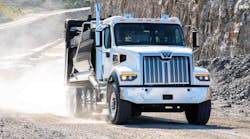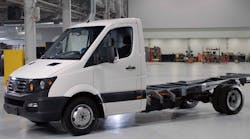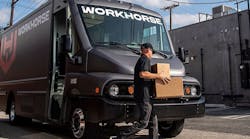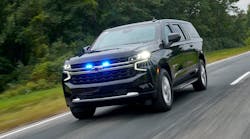Daimler has come up with its first rigid-body electric heavy truck concept, to go with the existing Fuso Canter E-Cell prototype light electric vehicle truck.
Here is IHS Automotive’s perspective:
The concept is based on the Mercedes-Benz heavy-duty three-axle short-radius distribution truck, with the conventional powertrain removed and replaced with a battery pack made up of three modules of lithium-ion batteries with a total capacity of 212 kWh. This gives the Urban eTruck a range of 200 km, which is enough effective range for a daily delivery round, according to Daimler. The battery power is delivered at the rear wheels of the truck through a set-up that uses an electrically driven rear axle with electric motors directly adjacent to the wheel hubs. These motors have a maximum output of 125 Kw each, with each motor offering peak torque of 500 Nm. Daimler claims that in combination with gearing, torque at each wheel is rated up to 11,000 Nm. The battery pack can be modified to add or take away cells depending on range and payload requirements, with charging taken care of by a standardized Combined Charging System (CCS) Type 2 connector; a completely discharged battery is capable of being charged in two to three hours. The Urban eTruck will make its public debut at the IAA International Motor Show for Commercial Vehicles in Hannover (Germany) in September.
Outlook and implications:
The weight of the battery pack, as well as its obvious packaging requirements, has until now stymied the creation of a fully electric heavy-duty truck. However, the progress that has been made in cell development in terms of increasing power storage and lowering cost means that this concept is now a viable one. The company claims that between 1997 and 2025, cell costs will have fallen by 60%, while power will have increased by 250% over the same period. The concept will work for heavy trucks up to 26 tonnes and is obviously best suited to inner-city delivery roles rather than on-highway use. The power required for an electric truck to drive at cruising speed on a motorway or autobahn would give such a vehicle a very short range indeed.
Daimler's electric truck concept will also be helped towards becoming a commercial reality by planned changes by the European Commission in favor of raising the gross vehicle weight of three-axle rigid trucks from 25 to 26 tonnes, which will help cancel out the weight penalty incurred by the battery and electric drivetrain. This change will see the effective weight penalty of the electric drivetrain fall to just 700 kg compared with the equivalent internal combustion engine (ICE) truck. The electric heavy-truck concept certainly has some important drivers to help it towards becoming a reality in terms of social demographics. In 2008, for the first time, more than half of the world's population lived in cities according to the United Nations, with this number set to rise to 70% by 2050.
In addition, there is increasing concern and awareness of air pollution from vehicles in China, which is likely to accelerate the commercialization of electric vehicles, while some major city authorities around the world, such as London and Paris, are actively hostile to diesel vehicles and are looking at legislation to ban them completely over time. Operators will also be attracted to the huge potential savings in fuels costs that could result from the use of electric vehicles, and the industry could be moving towards a medium-term future where out-of-town depots are serviced by efficient hybrid ICE highway trucks, with final deliveries in large urban environments undertaken by heavy electric rigid trucks.
In terms of light trucks, Daimler is already a pioneer of electric commercial vehicles with the Fuso Canter E-Cell. The Canter E-Cell has been successfully trialed in Portugal and has now completed a similar six-month field-testing process in Germany. The truck is much smaller and lighter than the Urban eTruck and has a battery pack of 48 kWh that powers an electric motor of 110 kW, while peak torque is 650 Nm, charged by the same standardized charger as its larger sibling. This gives the Canter E-Cell a range of 100 km, with 80% of this range available after just one hour's charging. Daimler is expected to announce plans to make this model commercially at the IAA International Motor Show. However, it is likely to be some time yet before the electric heavy-truck concept becomes commercially available.








